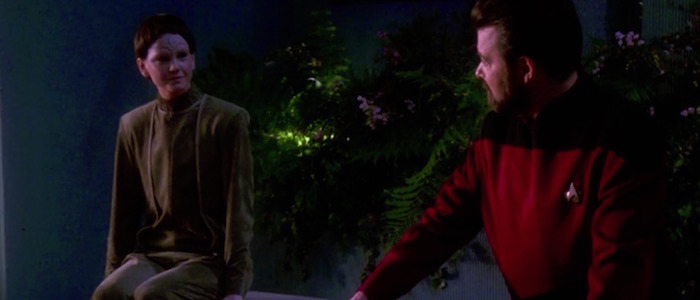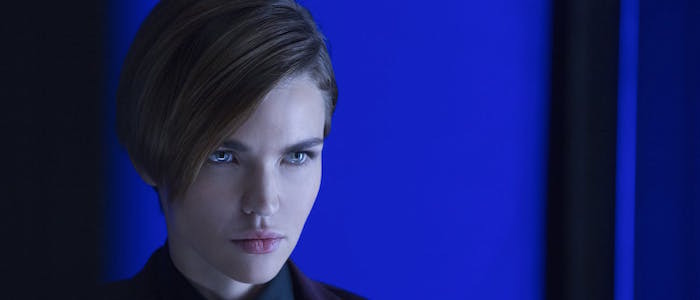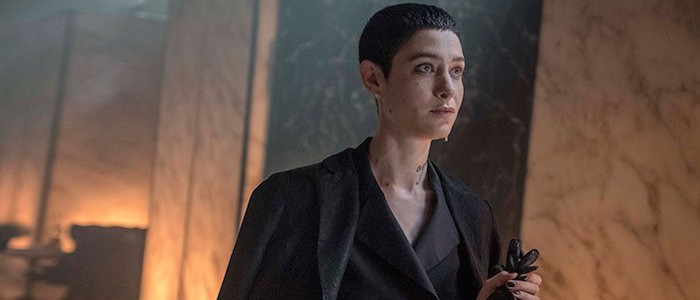'John Wick: Chapter 3' Features A Significant Non-Binary Character – Here's Why This Is A Big Deal
(Welcome to The Soapbox, the space where we get loud, feisty, political, and opinionated about anything and everything. In this edition: non-binary actor Asia Kate Dillon plays a non-binary character in John Wick: Chapter 3 and that means more than many people may realize.)As a non-binary person who loves cinema, I've resigned myself to the reality that I won't ever see my gender represented in mainstream popular culture. There have been major advances in binary transgender representation – particularly for trans women, though there's still a long way to go there too – but for those of us who don't fit neatly into the categories of men and women, there isn't a whole lot out there specifically meant for us. I find myself identifying with the masculinity of some characters, the femininity of others, and the gender-bending expressions of specifically queer art often scratches an itch for seeing gender-nonconformity represented in the works I've spent my life adoring and analyzing. But I never get to see a person who looks like me in the artistic medium I love, at least not without some major caveats.
But John Wick: Chapter 3 – Parabellum offered me something new. But we'll get there in a moment.
My Gender is Not a Metaphor
Gender-nonconformity is so often not allowed to simply exist in fiction. For example, a male actor cannot simply wear make-up or feminine clothing without it being commented upon or used as coded shorthand to indicate something about the character, usually camp villainy. Genders outside the male-female binary are often relegated to the realms of science fiction, where gender and sex are conflated in misguided parables about transgender identity and intersexism that portray non-hegemonic gender identity as bizarre and alien enough that human characters must necessarily remark upon it and analyze it.Which isn't to say that science fiction and fantasy don't serve a purpose in exploring gendered spaces and explaining gender theory to people of binary gender, albeit often in imperfect and necessarily elaborated upon ways. A memorable example lies in the Star Trek: The Next Generation episode "The Outcast," wherein the Enterprise encounters a race of androgynous aliens who effectively have one mode of gender expression and view male or female gender expression as a perverse taboo. The episode attempts to create an allegorical inverse of American human society to address issues like conversion therapy, repressed homosexual identity, and transgenderism, but the androgynous alien race (played entirely by women) is so broadly sketched as a representation of gender and sexual non-conformity that it doesn't effectively say anything of substance about the gender of these aliens beyond intolerance being bad, though it's binary gender which we see as discriminated against. The episode certainly pushed the boundaries of broadcast television in 1992 and was heralded as a milestone in exploring LGBT themes in mainstream popular culture, but it lacked a fundamental understanding of how gender and sexuality intersect, at least in portraying a sense of non-binary gender to an audience who might not otherwise immediately grasp the concept.The most conspicuous example in recent memory is probably non-binary artist Rebecca Sugar's cartoon series Steven Universe, which prominently features a large cast of alien characters whose concept of gender is unitary and divorced from human concepts of reproduction or personal expression. This show has been an excellent resource for exposing kids (and adults) to the world of non-binary gender, including binary gender human characters who experiment with various forms of gender expression, but it's also a step removed from reality, both by its nature as a cartoon and by its fantastical caveat that these non-binary creatures are alien and apart from humanity. Even Stevonnie, the show's only human character who explicitly functions as actual non-binary representation, is the result of the characters Steven and Connie fusing their bodies and personalities, creating a new person from a pair of distinct personalities in a way that doesn't reflect the reality of non-binary existence. It's metaphor, and it's deeply personal metaphor at that, but I'm also not a metaphor. I'm a person, and as much as I love Steven Universe for how it uses queer expression to speak to me in ways most other television doesn't, it doesn't entirely function on its own as a demonstration of actual non-binary existence.
The Value of Head-Canon
So what is a non-binary person to do if they don't see themselves explicitly represented in the media they consume? Well, we play in the negative space. We ascribe identity to characters who are shown to be ambiguous. The film or television show doesn't say that this character isn't non-binary, so who can say that they secretly aren't?In other words, we make shit up.Now, this is hardly unique to the non-binary community, as there is an entire subculture of fan-fiction writers devoted entirely to reinterpreting figures of popular media into more explicitly queer versions of themselves. That particular brand of fan-fiction arose from a need for adequate cultural representation in under-represented communities, and with the ability to proliferate stories on the internet, LGBT fans were able to create their own brand of fandom separate from the canon discourse. This separation, of course, is in no ways equal. A trans woman's story of Toni Stark's coming out as Iron Woman is not going to create the kind of cultural impact that a similar story would on the big screen, because fan-fiction doesn't create a zeitgeist; it is a reaction to the inadequacies of the zeitgeist. It's a form of queer art made for queer folks, and the only place to find it is in the niche purview of intrinsically queer spaces.Personally I'm not much of a fan-fiction reader, but I will often ascribe non-binary identity to characters played by actors who are, themselves, non-binary. Ezra Miller is genderfluid, but I'm under no illusion that Justice League's The Flash or Fantastic Beasts' Credence were written as genderfluid characters. Eddie Izzard is almost always cast as explicitly male characters, just as Tilda Swinton almost uniformly presents as female characters in her films. But if the material allows for any ambiguity, I'll latch onto it, because what else can I do? Ruby Rose's androgynous assassin in John Wick: Chapter 2 is a prime example of this, as she isn't really referenced as a non-binary character, but the look and the energy of Rose's performance are coded just butch enough that I can pretend that the character was written to be genderfluid as the person playing her.
Big Adjudicator Energy
So it's understandable that when I saw John Wick: Chapter 3 – Parabellum, I immediately started making those same sorts of head-canons as to Asia Kate Dillon's role as The Adjudicator, the badass investigator for the High Table who steals every single scene of their dedicated B-story. Dillon exudes a quiet yet overbearing power in the role, and more than once I was just astonished by how this clearly queer-coded character was allowed to just be in this universe, with no remarks as to their appearance or their demeanor, just abject acknowledgment of the power they wield without ever having to strike a blow or fire a bullet themselves. Regardless of how this character was written to identify, I knew that this performance from this non-binary actor was something I identified with.And of course, being the fanatic I am, I started poking around in other people's writing about Parabellum, seeing how other folks' perspective on the film compared with my own. That's when I started noticing something. While there was a fair share of misgendering Dillon in these pieces, the articles that properly attributed Dillon with they/them pronouns were also using those pronouns for The Adjudicator. My curiosity was piqued, and it didn't take much of a search to find this interview in The Advocate where Dillon talks about how The Adjudicator's gender identity was an explicit and foundational part of the character.The Adjudicator is canonically a non-binary character, just like the actor portraying them.I honestly struggle to describe the magnitude of how important this is to me as a non-binary person. I was aware of Dillon's portrayal of a non-binary character on the show Billions, but I just had never gotten around to watching it, and even then I wasn't particularly convinced that the show would have any better representation than the other attempts that have been made in television over the past couple decades. But then I hear straight from Dillon that The Adjudicator, this powerful androgynous force whose will is beyond reproach, shares with us an identity that we never see portrayed in cinema, and it feels like a revelation, like we've hit some sort of milestone and nobody's talking about it. I only wish the film itself had found a way to be more explicit about The Adjudicator's gender, to subtly nod to the non-binary folks in the audience that we aren't just projecting ourselves and our desires onto the character, that this character is one of us.Most importantly of all, though, The Adjudicator is human. The world of the John Wick films is heightened and melodramatic in the vein of the best that practical action cinema has to offer, but The Adjudicator isn't something ethereal that can be dismissed as an allegorical work of fantasy. They're a person, just like Asia Kate Dillon is a person, just like I'm a person, just like every non-binary person in the audience is a person. To see a person like me so casually presented would be a big deal even in a micro-budget indie film, but to see them in a franchise film that has taken the top spot at the box office is earth-shattering. Thank you Asia Kate Dillon, Chad Stahelski, Keanu Reeves, and everyone at Lionsgate who signed off on making The Adjudicator the landmark character they are. It changed everything, at least for this one non-binary fan.



